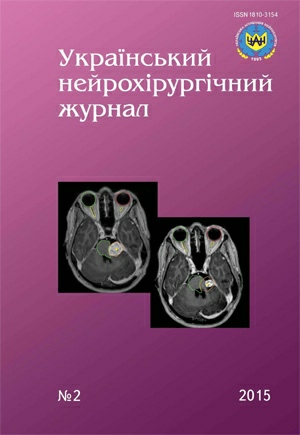The role of radiosurgery in the combined treatment of large vestibular schwannomas
DOI:
https://doi.org/10.25305/unj.45300Keywords:
vestibular schwannoma, combined treatment, microsurgery, stereotactic radiosurgery, linear acceleratorAbstract
Purpose. To optimize treatment tactics at large vestibular schwannoma (VS) based on stereotactic radiosurgery (SRS) results analysis and efficiency evaluation as the post-operative phase of combined treatment.
Materials and methods. 22 patients with large VS, previously operated in 2010–2014 were included in the study. SRS was performed using linear accelerator “Trilogy” (“Varian”, USA). Target irradiation size was in average was 8,617 cm3, prescribed dose (PD) — 12.54 Gy, the maximum dose — 14.3 Gy.
Results. The observation period after SRS ranged from 7 to 48 months, on an average — 26.7 months. Monitoring included regular clinical and radiological examinations: for the first year of observation — every 3 months, further — every 6 months. In 18 patients in a period of 12 months the size of the irradiated HS decreased or remained unchanged in 78%, in 15 patients in a period of 24 months — 93%, and in all 5 patients in a period 36 months. After SRS neurological status improved in 45% patients, functional status (according to the Karnofsky scale) — in 26%.
Conclusions. SRS as a post-operative phase of large VS combined treatment ensured control of tumor growth, improved patient’s functional state, reduced neurological deficits, minimized risk associated with cranial nerves dysfunction.
References
Arthurs BJ, Fairbanks RK, Demakas JJ, Lamoreaux WT, Giddings NA, Mackay AR, Cooke BS, Elaimy AL, Lee CM. A review of treatment modalities for vestibular schwannoma. Neurosurgical Review. 2011;34(3):265-279. CrossRef
Wolbers J, Dallenga A, Mendez Romero A, van Linge A. What intervention is best practice for vestibular schwannomas? A systematic review of controlled studies. BMJ Open. 2013;3(2):e001345-e001345. CrossRef
Régis J, Roche P. Modern Management Of Acoustic Neuroma. Basel: Karger; 2008.
Sarmiento J, Patel S, Mukherjee D, Patil C. Improving outcomes in patients with vestibular schwannomas: microsurgery versus radiosurgery. J Neurosurg Sci. 2013 March; 57(1): 23–44. PubMed
Mahboubi H, Ahmed O, Yau A, Ahmed Y, Djalilian H. Complications of Surgery for Sporadic Vestibular Schwannoma. Otolaryngology -- Head and Neck Surgery. 2013;150(2):275-281. CrossRef
Bloch O, Sughrue ME, Kaur R, Kane AJ, Rutkowski MJ, Kaur G, Yang I, Pitts LH, Parsa AT. Factors associated with preservation of facial nerve function after surgical resection of vestibular schwannoma. Journal of Neuro-Oncology. 2010;102(2):281-286. CrossRef
Ansari S, Terry C, Cohen-Gadol A. Surgery for vestibular schwannomas: a systematic review of complications by approach. Neurosurgical Focus. 2012;33(3):E14. CrossRef
Iwai Y, Yamanaka K, Ishiguro T. Surgery combined with radiosurgery of large acoustic neuromas. Surgical Neurology. 2003;59(4):283-289. CrossRef
Rykaczewski B, Zabek M. A meta-analysis of treatment of vestibular schwannoma using Gamma Knife radiosurgery. Contemp Oncol. 2014;1:60-66. CrossRef
Myrseth E, MГёller P, Pedersen P, Lund-Johansen M. Vestibular schwannoma: surgery or gamma knife radiosurgery? A prospective, nonrandomized study. Neurosurgery. 2009;64(4):654-663. CrossRef
Rodriguez-Mena R, Gallego-Sanchez JM, Gonzalez-Bonet LG, Goig-Revert F, Barcia-Marino C, Rosello-Ferrando J. [Linear accelerator radiosurgery for the treatment of vestibular schwannoma]. Rev Neurol. 2011;52(5):275-82. Spanish. PubMed
Badakhshi H, Graf R, Bohmer D, Synowitz M, Wiener E, Budach V. Results for local control and functional outcome after linac-based image-guided stereotactic radiosurgery in 190 patients with vestibular schwannoma. Journal of Radiation Research. 2013;55(2):288-292. CrossRef
Nagano O, Serizawa T, Higuchi Y, Matsuda S, Sato M, Yamakami I, Okiyama K, Ono J, Saeki N. Tumor shrinkage of vestibular schwannomas after Gamma Knife surgery: results after more than 5 years of follow-up. J Neurosurg. 2010;113:122–127. PubMed
Link M, Driscoll C, Foote R, Pollock B. Radiation Therapy and Radiosurgery for Vestibular Schwannomas:. Otolaryngologic Clinics of North America. 2012;45(2):353-366. CrossRef
Pollock BE, Lunsford LD, Kondziolka D, Sekula R, Subach BR, Foote RL, Flickinger JC. Vestibular schwannoma management: Part II. Failed radiosurgery and the role of delayed microsurgery. J Neurosurg. 2013;119:949-55. PubMed
Patel J, Vasan R, van Loveren H, Downes K, Agazzi S. The changing face of acoustic neuroma management in the USA: Analysis of the 1998 and 2008 patient surveys from the acoustic neuroma association. Br J Neurosurg. 2014;28(1):20-24. CrossRef
Koos W, Spetzler R, Böck F, Salah S. Microsurgery of cerebellopontine angle tumors. In: Koos W, Böck F, Spetzler R, ed. Clinical Microneurosurgery. Stuttgart: Thieme; 1976:91–112.
Hayhurst C, Zadeh G. Tumor pseudoprogression following radiosurgery for vestibular schwannoma. Neuro-Oncology. 2011;14(1):87-92. CrossRef
Downloads
Published
How to Cite
Issue
Section
License
Copyright (c) 2015 Oksana Zemskova

This work is licensed under a Creative Commons Attribution 4.0 International License.
Ukrainian Neurosurgical Journal abides by the CREATIVE COMMONS copyright rights and permissions for open access journals.
Authors, who are published in this Journal, agree to the following conditions:
1. The authors reserve the right to authorship of the work and pass the first publication right of this work to the Journal under the terms of Creative Commons Attribution License, which allows others to freely distribute the published research with the obligatory reference to the authors of the original work and the first publication of the work in this Journal.
2. The authors have the right to conclude separate supplement agreements that relate to non-exclusive work distribution in the form of which it has been published by the Journal (for example, to upload the work to the online storage of the Journal or publish it as part of a monograph), provided that the reference to the first publication of the work in this Journal is included.









